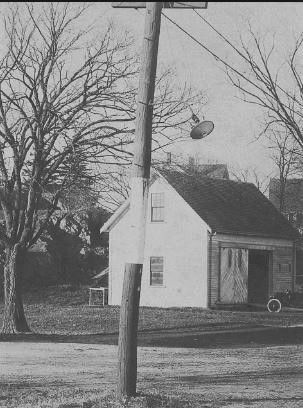Hingham Municipal Lighting Plant, MA, 1896 Electric Service Pole, Street Light
By Joe Maurath, Jr.; posted June 21, 2020
View Original: Click to zoom, then click to magnify (303 x 408) 74KB

|
The electric light was a cutting edge innovation for decades, especially through the 1890s as it gained popularity. Ongoing improvements in lighting technology was continuing, resulting in improved lamps and accessories resulting with a better and reduced cost of light. The electric utilities (especially those in smaller and more affluent communities) were doing their best to make their lines and street lamp fixtures "attractive". In addition dependability of all electric circuits were critical and of high priority. Below are some notes describing how Hingham, MA dealt with these issues during 1896 - 1897. Shown is an early 1890s incandescent fixture on a Hingham pole during 1896 or 1897. Below you will read about how the general manager of this utility kept these lights in tip-top shape. The street lighting circuits that served the town originated at a generation station in neighboring East Weymouth. These lines consisted of two "loops" that transversed around Hingham. During 1896, 371 street lights were in service and 13 added during the following year. Mr. Corthell, general manager, reported: "I propose to have all remaining light shades showing the effect of the weather, repainted and when this is done, the line will, I believe, equal in its neat appearance any in the State. The Weymouth company purchased a new 25 k.w. machine... for one of the two street lighting circuits serving the town." Timely payment of electricity bills met with reward. A 20% bill discount continued during 1896 and 1897 if paid in full within 15 days of receipt. During 1896 the Hingham system had 146 customers with 3,066 lightbulbs connected to the 110 miles of wire the Light Plant owned. Eleven new customers were added in 1897. Construction of the town's street railway began in the spring of 1896 and ran along main thorofares. The railway company shared poles with the Light Plant. Many had to be replaced on account of the heavy DC cables that were strung upon them. Others had to be renewed owing to overhead clearance issues. The cost of installing new and stronger poles was shared by the railway and Light Plant. At the end of 1895 there were 367 street lights in town with about 1,027 poles with 242,880 feet of wire supporting the street lighting and customer lighting circuits. 22 new customers were added during 1895 and there were 2,647 lamps (lightbulbs) connected via meter. Note: a few customers were still charged a flat rate per lightbulb they used; that would soon change in fairness to all customers. General Manager Wallace Corthell reported: "During the summer (of 1895) all of the poles upon which street lamps are placed were numbered, so that when the department is notified of defective lamps it is only necessary to give the number of the pole and name of the street. I wish to thank those citizens who have so kindly sent such notifications and trust in the future general use will be made of the postal cards to be obtained at business places in many parts of the town, and that the department will be promptly informed of any defect in the lines." Originally the town's pole numbers were stenciled onto them. At some time in the early 1900s rectangular pole tags were employed with the pole number and Light Plant (and the pole's joint owner, if applicable) stamped onto approximately 2 by 3-inch copper plates. Coming: The Big Gales of 1898. |